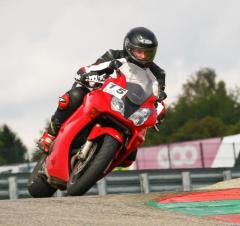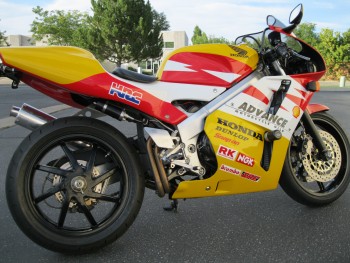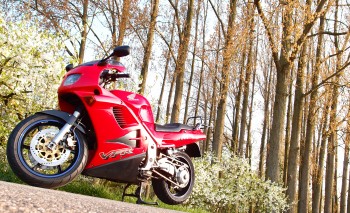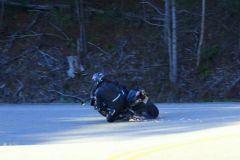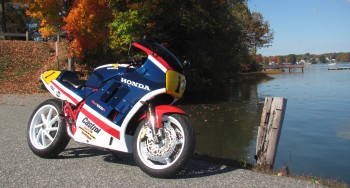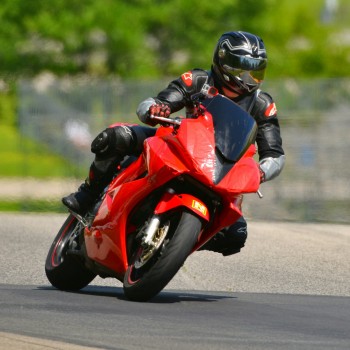-
Posts
397 -
Joined
-
Last visited
-
Days Won
3
Content Type
Forums
Profiles
Gallery
Blogs
Downloads
Events
Everything posted by RC36Rider
-
You are welcome. One thing that might give you grief, though is the remote preload hose and knob. I'm not positive that they are routed to the same side and of similar lengths. The Bird's shock is a confirmed OK fit on the 6th Gen.
-
They are not identical but close enough that the 1200 should be usable. The mounting points are compatible, AFAIK. Here's the data from Öhlins for the 6th Gen: And for the 1200:  - Longer OAL will raise the back about 1/2". - Shorter stroke might reduce wheel travel a bit but I don't see that as a real issue. - Slightly heavier spring which is a boon unless you are a horse jockey.
-
Hi RC36Rider, Thank you for your donation of 10.00 USD. We look forward to improving the forums with your donation. Thanks VFRDiscussion
-
-
-
He's on Facebook now. Progress has been halted for a long time due to some 2 stroke salvage operation but he's back at it.
-
This may be of interest: The RVF Project
-
-
-
Correct. I'm not 100% sure I recall correctly but I think the stock top bolt is long enough for 6 mm.
-
You'll need to shim the top mount about 6 mm (319 -> 325 mm) to compensate for the length difference. Other than that, it should bolt on with no issues. The Bird's shock also has a slightly shorter stroke so you'll lose a bit of wheel travel but it's travel you don't use under 99% of riding circumstances so no big deal IMO.
-
-
Just checked my records and the DMr recommendation for your weight class is 0.85/18.77 (1050 #/in actually as he uses US made springs) for a ratio of 22+. I hope he'll forgive my audacity if he reads this but my own research suggests that this shock spring rate to fork spring rate is a bit on the high side for lighter riders. Might serve you well if you ride with pillion/luggage, though.
- 11 replies
-
- 1
-

-
- f4i forks
- 4pot calipers
-
(and 2 more)
Tagged with:
-
I am certainly no expert but based on what I could gather (from this board, Öhlins, my own experience with 0.90 fork springs) that sounds fairly reasonable to me. Should give you a firm setup (on the sport side of sport-touring) but nothing like race hard. I reckon (own calculations) that will give you about 35 mm of front-end sag @ 15 mm of preload which is a good ballpark for spirited riding on public roads. Note that spring rates play a fairly minor role in how harsh your suspension will feel. Damping is mostly what causes harshness (aside from excessive friction) so bumpy/crappy roads are not a good reason to go to lighter springs. Shock spring rate on the 6G should be about 20-22 times the fork spring rate. Taller/heavier guys should aim for 22, 20 for shorter/lighter folks. Feel free to question my 'wisdom'.
- 11 replies
-
- 1
-

-
- f4i forks
- 4pot calipers
-
(and 2 more)
Tagged with:
-
Both bikes have 43 mm RWU forks and RT use the same spring reference (FRSP S3732) for both bikes so it seems likely that they will swap just fine. I know RT say that they are 0.85 but that figure has been questioned on this board (0.74 has been quoted). They are also definitely dual rate springs (taper + uneven spacing of the coils). As for re-valving, forks are relatively easy to work on but it's a messy and time consuming job especially if you go your own way and have to go through several iterations. Reworking an OEM Showa typically requires drilling and tapping to install a nitrogen valve, a safe way to compress the spring (downright dangerous amounts of force required) and you'll have to find someone who can recharge the nitrogen when you're done. Might be more trouble than you've bargained for. RT will give you a generic kit of loose parts and (vague-ish) instructions on how to select a suitable shim stack. DMr will send you a custom pre-assembled shim stack. There are other vendors (Öhlins, Penske ...) but I don't know what their kits look like. Don't want to discourage you. Just trying to give you a fair idea of what you're letting yourself in to.
- 11 replies
-
- f4i forks
- 4pot calipers
-
(and 2 more)
Tagged with:
-
That seems unlikely. Check your sag, adjust your preload accordingly and play with the damping adjuster a bit. The (admittedly pretty rubbish) stock shock is softly sprung but can be adjusted very hard, especially at your weight. I'm over 210 w/o gear and it kicks like a mule if I give it too much preload and turn the adjuster near full hard.
- 11 replies
-
- f4i forks
- 4pot calipers
-
(and 2 more)
Tagged with:
-
Not sure what you mean by 'some results' from RT. At your weight, RT recommend a 17.8 kg/mm spring for the 6G. To 'calculate' spring rate you need to have some pretty accurate figures for sprung weight, weight distribution and, most importantly, linkage ratio. These are not very easy to come by and the linkage ratio is a VFR peculiarity (significantly higher leverage than most anything else on the market these days). If you used another bike on the RT calculator and input the VFR's weight, that might give you acceptable results for the forks but the shock will likely be way off.
- 11 replies
-
- f4i forks
- 4pot calipers
-
(and 2 more)
Tagged with:
-
If memory serves, these bikes all have a clevis as lower shock mounting point and a significantly lower linkage ratio than the VFR with correspondingly (much) lower spring rates. These will require some serious mods to be usable. Older CBR 600 F and CBR 900/929/954 were more similar to the VFR but the V4 architecture and the LBS/ABS plumbing also puts physical space at a premium so even these do not fit all that well. DMr offer the CBR F4 shock for the 6G and the 929 for the 5G. They are the best fit but they still require mods to get the proper length and access to the adjusters may not be all that great, especially preload on the 6G/F4 swap.
- 11 replies
-
- f4i forks
- 4pot calipers
-
(and 2 more)
Tagged with:
-
RT basically consider the CBR as a sportsbike, expected to handle as such and be used as such (e.g. track days, smooth twisties), and the VFR as a sports-tourer. Evidence for this is their 'Recommended Preload' which is 10 mm for the CBR and 15 mm for the VFR. This is IMO why inputting the VFR's weight on the CBR page yields a stiffer spring rate.
- 11 replies
-
- f4i forks
- 4pot calipers
-
(and 2 more)
Tagged with:
-
Semi-wet = all fluids but empty tank. Sprung weight = basically the weight actually bearing on the springs i.e. not counting the wheels, brakes, fork sliders, some part of the swingarm... Seen like this, the 218 odd kg used for the 6th Gen makes more sense.
-
Actually ... the weight displayed by the RT calculator could be a fairly accurate sprung weight which is what spring rate calculations should be based on.
-
Race Tech have updated their 'calculator' for the 6th Gen. It now yields the following results for a 90 kg Street rider: F: 0.987 kg/mm R: 20.337 kg/mm I ran the same scenario not so long ago (I forgot when exactly) and I got 17.837 kg/mm. PS: Yes, I know the last comment on this thread is going for 4 years old but it's still pinned so ...
-
Says the man who rides a 4th Gen in 2015. Either it was never much of a fortune or you are one heavy drinker. Or a hell of a womanizer. Just kiddin'. Still a great bike IMO.
-
I've got a feeling that you'll develop a bit of sympathy for Honda's predicament in 'giving their customers what they want'.


